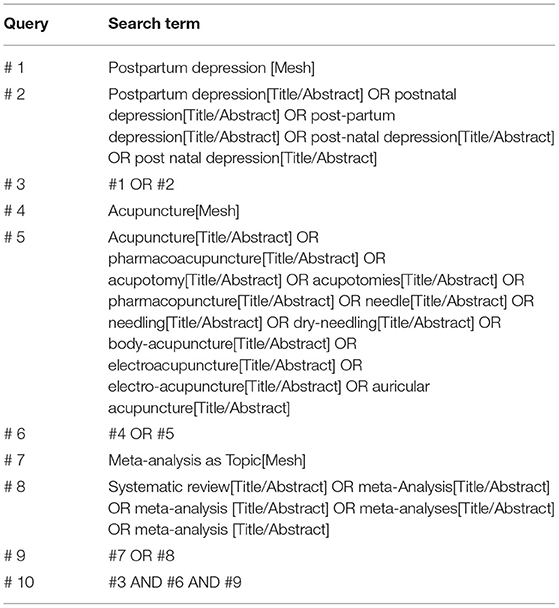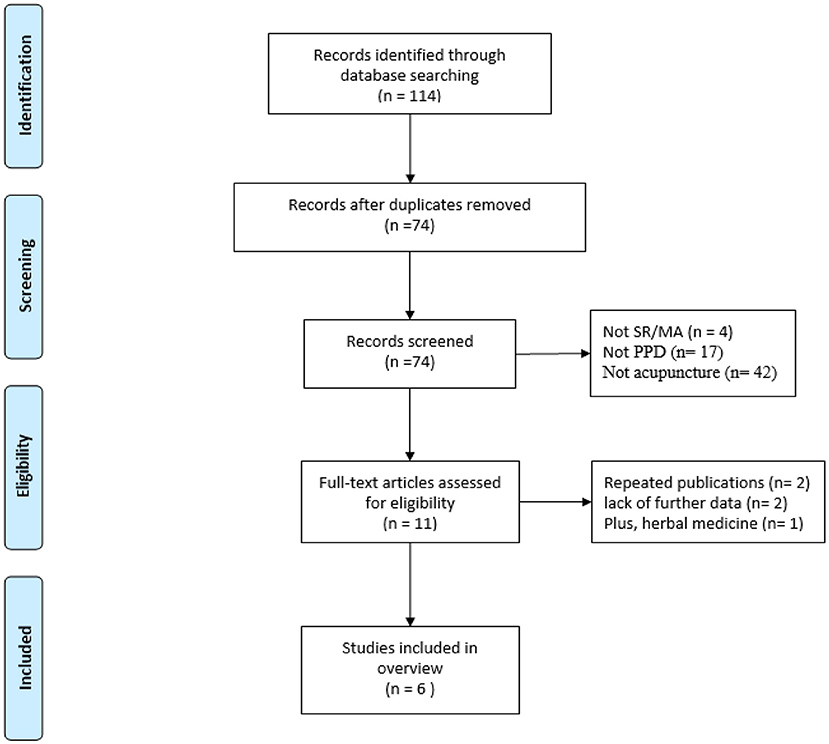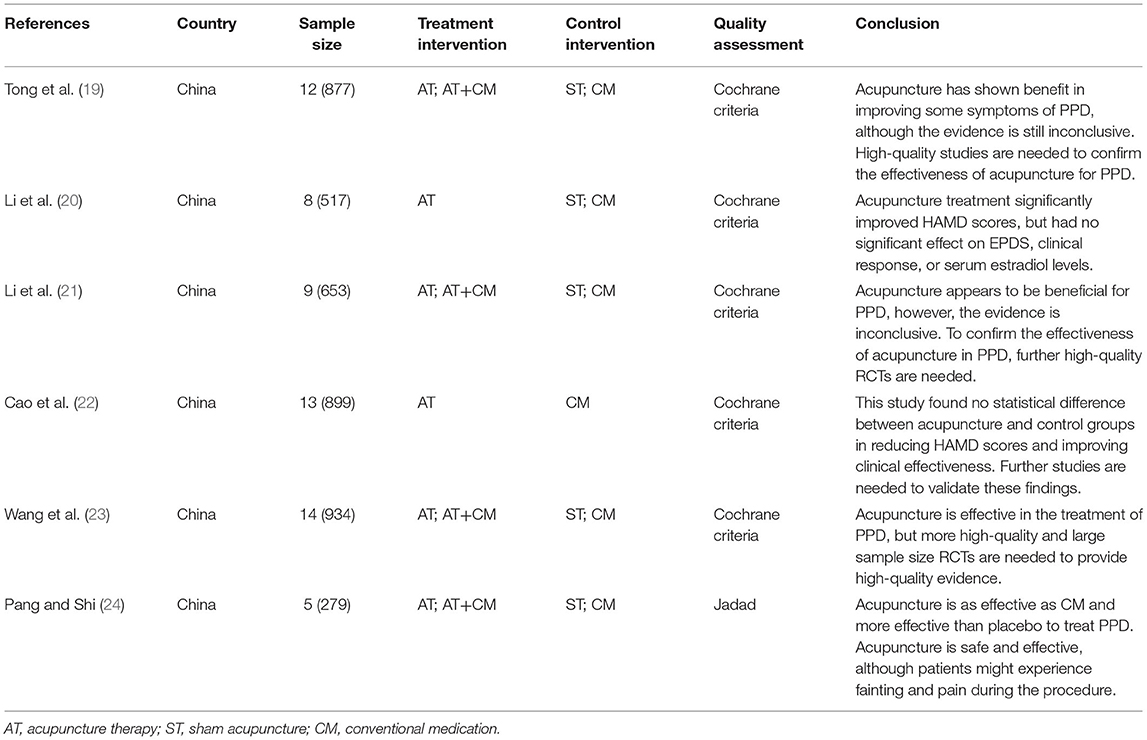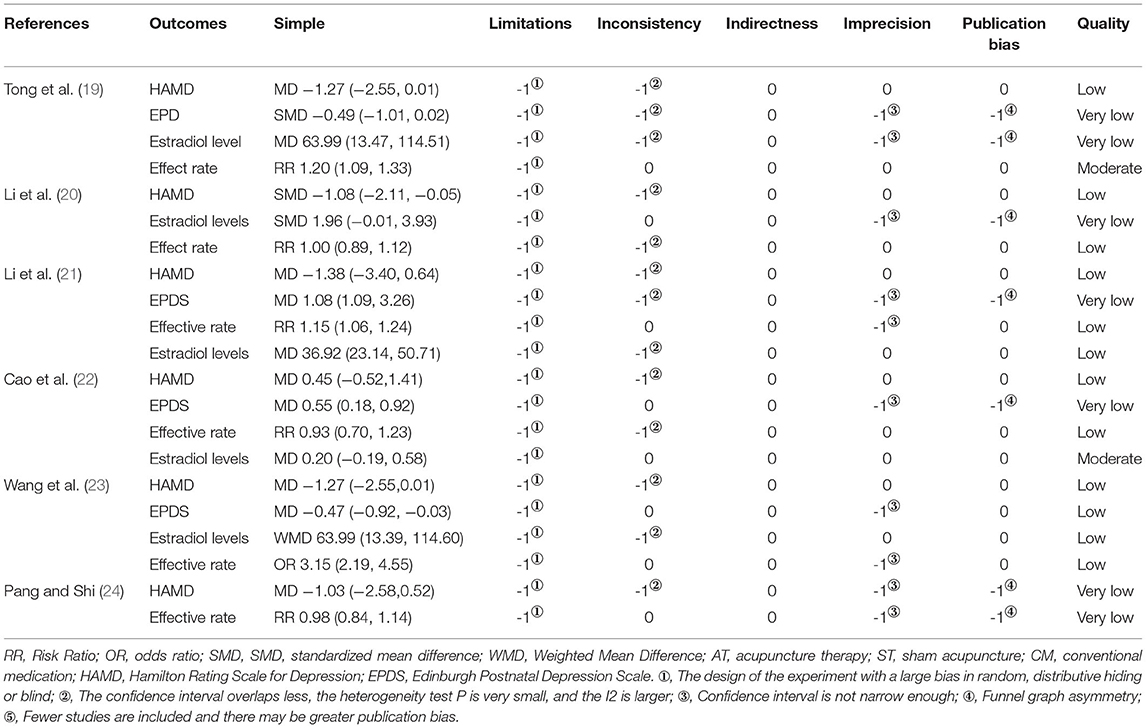- 1Nanchang Hongdu Hospital of Traditional Chinese Medicine, Nanchang, China
- 2Department of Acupuncture, Changshu Hospital Affiliated to Nanjing University of Chinese Medicine, Changshu, China
- 3Tianjin University of Traditional Chinese Medicine, Tianjin, China
Background: There is conflicting evidence on the effectiveness of acupuncture in the treatment of postpartum depression (PPD). This study aimed to assess previous systematic reviews/meta-analyses (SRs/MAs) on the effectiveness of acupuncture to treat PPD.
Method: SRs/MAs regarding the use of acupuncture for PPD were identified from the establishment of digital databases to November 2021. The Assessing the Methodological Quality of Systematic Reviews 2 (AMSTAR-2) was applied to evaluate the methodological quality of included SRs/MAs. The Grades of Recommendations, Assessment, Development and Evaluation (GRADE) was utilized to evaluate the evidence quality for outcomes of interest.
Results: Six studies that conducted quantitative syntheses were included. According to AMSTAR-2, the methodological quality of these SRs/MAs was critically low owing to limitations of items 2, 4, and 7. According to GRADE, no study included high-quality evidence and most studies included low-quality evidence.
Conclusions: Acupuncture m be beneficial for PPD, however, due to limitations of current evidence and inconsistent findings, further studies are needed to provide stronger evidence to draw definitive conclusions.
Introduction
Postpartum depression (PPD) is a mood disorder associated with childbirth, since its onset begins between the first day and 4 months after delivery (1). Typically, PPD occurs within 6 weeks postpartum and patients tend to recover in 3–6 months, while severe cases can persist for up to 2 years. The prevalence of PPD in first-time mothers is as high as 16% (2), and the recurrence rate of PPD in the second pregnancy reaches 30% of women (3, 4). PPD is characterized by a depressed mood, loss of interest, sleep disturbances, psychomotor agitation or retardation, feelings of worthlessness, and even suicidal thoughts and behaviors in severe cases (5). Given the high prevalence and deleterious impact of PPD, the development of effective treatments is needed.
Treatment of PPD includes pharmacotherapy, psychotherapy, or both, which is consistent with the treatment recommended in guidelines for major depression (6). However, these treatments vary in efficacy (7–9), are cost (10), while adverse events are common (11, 12). Therefore, more effective and safer treatments for PPD are still needed. In this regard, acupuncture is perceived as an effective and safe alternative (13). A number of systematic reviews (SRs)/meta-analyses (MAs) have evaluated the efficacy of acupuncture for PPD, however their findings are inconsistent and the evidence credibility is unclear. Therefore, we provide a critical evaluation of SRs/MAs on the use of acupuncture to treat PPD.
Methods
This study followed the methodology of the Cochrane Handbook and high-quality studies (14–16).
Eligibility Criteria
The following eligibility criteria were used to screen studies: (a) SRs/MAs based on randomized controlled trials (RCTs) on the use of acupuncture to treat PPD; (b) participants diagnosed with PPD by a recognized guideline; (c) interventions included acupuncture therapy or acupuncture plus conventional medication (CM), while the control group was treated with CM, CM plus acupuncture, sham acupuncture, or other non-pharmacological therapy; (d) outcomes included the Hamilton Rating Scale for Depression (HAMD), Edinburgh Postnatal Depression Scale (EPDS), effective rate and estradiol levels. Repeated publications or studies lacking complete data were removed.
Search Strategy
Embase, PubMed, Web of Science, Cochrane Library, CNKI, CBM, Wanfang, and VIP were searched for studies published between database creation and November 2021. The following search terms were applied: postpartum depression, acupuncture, meta-analysis, and systematic review. Table 1 presents the search strategy for the PubMed database.
Data Collection and Extraction
Two independent evaluators screened abstracts and titles, and then assessed potentially eligible full texts for final inclusion. Disagreements were resolved through discussion with a third independent reviewer. The following data were extracted from included studies: first author, year of publication, country, sample size, interventions, outcomes, quality assessment methods, and summary estimates of effect.
Quality Assessment
Two independent evaluators assessed the methodological quality of SR/MA using the Assessment of Methodological Quality of Systematic Evaluation 2 (AMSTAR-2) (17). AMSTAR-2 consists of 16 items, each with three possible answers, i.e., “yes,” “partially yes,” or “no.” When up to one non-critical item does not meet the requirements, the methodological quality is considered “high”; when more than one non-critical item does not meet the requirements, the methodological quality is considered “medium”; when one critical item does not meet the requirements, the methodological quality is considered “low” and when more than one critical item do not meet the requirements, the methodological quality is deemed “very low” (17).
Two independent evaluators used the Grade of Recommendation, Assessment, Development and Evaluation (GRADE) (18) to assess the quality of evidence for each outcome indicator. GRADE ranks the evidence according to risk of bias, indirectness, imprecision, inconsistency, and publication bias. Each outcome measure is rated on four levels, i.e., “high,” “moderate,” “low,” or “very low” (18).
Data Synthesis and Presentation
A narrative synthesis was used in this overview. The characteristics and results of each SR/MA as well as results from AMSTAR 2 were summarized by tabulation. The GRADE evidence profile and summary of findings table were generated using the GRADE pro GDT online software.
Results
Study Selection
The literature search identified 114 articles, of which 40 duplicates were removed. Titles and abstracts of 74 articles were screened, and 63 articles were subsequently excluded. The full text of the remaining 11 articles was read and five articles were excluded. Therefore, six papers were included in our analyses (19–25). The selection process is shown in Figure 1.
Study Characteristics
All included studies were conducted in China and published within the last 5 years. All studies were MAs with significant differences in sample size (5–14 studies, 27–934 participants). The interventions in the experimental group were acupuncture, or a combination of acupuncture and CM, while the control interventions were CM and/or sham acupuncture. Details on study characteristics are reported in Table 2.
Methodological Appraisal
All studies were rated as very low quality according to the AMSTAR-2 criteria. The key factors contributing to lower methodological quality were item 2 (only one review registered a protocol), item 4 (half of the studies did not provide a search strategy), and item 7 (all reviews did not provide a list of excluded studies). Detailed assessment results of AMSTAR-2 are shown in Table 3.
GRADE Evidence Quality Classification
A total of 19 outcome indicators were assessed. No indicator was deemed high, while two were moderate, 12 were low and five were very low quality of evidence. Risk of bias was the most common reason for downgrading the evidence, followed by inconsistency, imprecision, publication bias, and indirectness. Details are shown in Table 4.
Description of Efficacy
All studies used the HAMD to assess the severity of depression, and one review (20) concluded that acupuncture treatment improved depressive symptoms more significantly than CM, however, five reviews (19, 21–24) showed no significant difference between the two groups. Four reviews (19, 21–23) reported the EPDS of acupuncture vs. CM, in which three reviews showed that acupuncture was more effective than the control group (21–23) and one review showed no significant difference (19). The effective rate was reported in all reviews. Three of which revealed that acupuncture was more effective than the control group (19, 21, 23) while the other three reviews found no difference (20, 22, 24). Estradiol levels were reported in five reviews (19–23), in which three reviews found a significant effect for acupuncture when compared to the control group (19, 21, 23) and one review found no difference (20, 22).
Discussion
Acupuncture is routinely used in clinical therapy for PPD in China as a way to improve therapeutic effectiveness. Numerous SRs/MAs have evaluated the effectiveness of acupuncture for PPD, however, inconsistent results have been reported. In this context, a critical evaluation of different SRs/MAs and a summary of the scientific nature of the evidence is necessary (25). Furthermore, an overview can highlight deficiencies that need to be improved to guide future high-quality RCTs or SRs/MAs (26).
A total of six SR/MAs were included in this study, all of which were published in the past 5 years, suggesting that more researchers are beginning to study acupuncture as an alternative therapy for PPD. Nineteen outcome measures on the effectiveness of acupuncture to treat PPD were evaluated, and although most indicators suggested positive results, these were inconsistent. Furthermore, although most of the included studies suggested that acupuncture was effective as a treatment for PPD, most authors did draw firm conclusions due to the low methodological quality of evidence or the small size of included trials. Indeed, all reviews were considered to be of very low quality according to AMSTAR-2 criteria. Therefore, our analysis concluded that acupuncture might be an effective treatment for PPD, but such conclusion must be treated with caution due to limitations of the current evidence.
Over recent years, AMSTAR-2 has become the most widely used tool to evaluate the methodological quality of SRs/MAs. All included studies had more than one critical flaw, so that there is very low confidence in their results. The key factors contributing to this setting were item 2 (only one review registered a protocol), item 4 (half of the studies did not provide a search strategy), and item 7 (all reviews did not provide a list of excluded studies). It was found that study protocols contribute to increased transparency of the methodology used and improve the overall methodological quality of SRs/MAs (27). The absence of a specific search strategy can result in an unreproducible search process, which leads to significant bias in included and excluded studies, undermining the scientific validity of findings. Likewise, by not presenting a list of excluded studies, authors can concur to incorrect exclusion of key literature, undermining the rigor of the report. Therefore, future SRs/MAs should address these identified deficiencies to develop high-quality studies and thus provide high-quality evidence.
In this study, authors of the included SRs/MAs did not draw definitive conclusions. Indeed, after rating the evidence using the GRADE system, we found that the certainty of evidence was unsatisfactory, indicating that findings of the included SRs/MAs are uncertain. Although all SRs/MAs evaluated only RCTs, the certainty of evidence was limited owing to the risk of bias (lack of blinding and allocation concealment), inconsistency, imprecision, or publication bias. The results of the methodological quality evaluation of RCTs showed that there is room for addressing random, distributed hidden or blind biases. Nevertheless, we must acknowledge that there are specificities of acupuncture therapy (inability to blind physicians and patients) that make the implementation of RCTs challenging. Improved standardization and precision of acupuncture techniques and procedures are urgently needed, as only a rigorously designed and implemented RCT can reduce the risk of bias and therefore assess the effectiveness of interventions (28).
To our knowledge, this is the first overview of SRs/MAs summarizing the current evidence on the use of acupuncture to treat PPD. The methodological and evidence qualities of the included SRs/MAs may help to inform evidence-based decision-making and guide future high-quality studies. However, our study presents some limitations. First, the quality analysis demonstrated numerous methodological flaws in the performance of SRs/MAs, and the evidence quality was not satisfactory, making it impossible to draw firm conclusions about the use acupuncture for PPD. Second, the rapid growth in the number of SRs/MAs highlights challenges faced by healthcare decision-makers and researchers in keeping up with the evidence. This overview found that there were typically a large number of low-quality SRs/MAs. To help evidence-based practice, there is an urgent need for high-quality SRs/MAs that do not overlap and are up to date. Furthermore, widely used AMSTAR-2 tool and GRADE system are subjective evaluation tools, therefore the accuracy of assessments can vary. To mitigate this limitation, quality assessments were performed by two independent authors.
Conclusion
Acupuncture might be beneficial for PPD. However, due to limitations of the current evidence and inconsistent findings, further studies are needed to provide strong evidence to draw definitive conclusions.
Data Availability Statement
The original contributions presented in the study are included in the article/supplementary material, further inquiries can be directed to the corresponding authors.
Author Contributions
XH and QF conceived the study and drafted the manuscript. LM, RJ, RG, and XZ help with the implementation of research. FQ and LZ provided guidance on the overview methodology. LM revised the manuscript. All authors read, critically reviewed, and approved the final manuscript as submitted.
Funding
This work was funded by Jiangxi Provincial Department of Science and Technology Key Research and Development Program General Project (No. 20192BBGL70037) and Changshu Science and Technology Development Plan Project (No. CS202136).
Conflict of Interest
The authors declare that the research was conducted in the absence of any commercial or financial relationships that could be construed as a potential conflict of interest.
Publisher's Note
All claims expressed in this article are solely those of the authors and do not necessarily represent those of their affiliated organizations, or those of the publisher, the editors and the reviewers. Any product that may be evaluated in this article, or claim that may be made by its manufacturer, is not guaranteed or endorsed by the publisher.
Abbreviations
PPD, postpartum depression; SR, Systematic review; MA, Meta-analysis; AMSTAR-2, Assessing the Methodological Quality of Systematic Reviews 2; GRADE, Grading of Recommendations, Assessment, Development, and Evaluation; RCTs, Randomized clinical trials; CM, conventional medication; HAMD, Hamilton Depression Scale; EPDS, Edinburgh Postnatal Depression Scale.
References
1. Lee D, Yip A, Chiu H, Leung T, Chung T. A psychiatric epidemiological study of postpartum Chinese women. Am J Psychiatry. (2001) 158:220–6. doi: 10.1176/appi.ajp.158.2.220
2. Viguera AC, Tondo L, Koukopoulos AE, Reginaldi D, Lepri B, Baldessarini RJ. Episodes of mood disorders in 2,252 pregnancies and postpartum periods. Am J Psychiatry. (2011) 168:1179–85. doi: 10.1176/appi.ajp.2011.11010148
3. Payne JL, Maguire J. Pathophysiological mechanisms implicated in postpartum depression. Front Neuroendocrinol. (2019) 52:165–80. doi: 10.1016/j.yfrne.2018.12.001
4. Shorey S, Chee CYI, Ng ED, Chan YH, Tam WWS, Chong YS. Prevalence and incidence of postpartum depression among healthy mothers: a systematic review and meta-analysis. J Psychiatr Res. (2018) 104:235–48. doi: 10.1016/j.jpsychires.2018.08.001
5. American Psychiatric Association. Diagnostic and Statistical Manual of Mental Disorders (DSM-V). 5th Edn. Arlington, VA: American Psychiatric Association (2013).
6. Stein A, Pearson RM, Goodman SH, Rapa E, Rahman A, McCallum M, et al. Effects of perinatal mental disorders on the fetus and child. Lancet. (2014) 384:1800–19. doi: 10.1016/S0140-6736(14)61277-0
7. Cipriani A, Furukawa TA, Salanti G, Chaimani A, Atkinson LZ, Ogawa Y, et al. Comparative efficacy and acceptability of 21 antidepressant drugs for the acute treatment of adults with major depressive disorder: a systematic review and network meta-analysis. Lancet. (2018) 391:1357–66. doi: 10.1016/S0140-6736(17)32802-7
8. Cipriani A, Furukawa TA, Salanti G, Geddes JR, Higgins JP, Churchill R, et al. Comparative efficacy and acceptability of 12 new-generation antidepressants: a multiple-treatments meta-analysis. Lancet. (2009) 373:746–58. doi: 10.1016/S0140-6736(09)60046-5
9. Amick HR, Gartlehner G, Gaynes BN, Forneris C, Asher GN, Morgan LC, et al. Comparative benefits and harms of second generation antidepressants and cognitive behavioral therapies in initial treatment of major depressive disorder: systematic review and meta-analysis. BMJ. (2015) 351:h6019. doi: 10.1136/bmj.h6019
10. Karyotaki E, Tordrup D, Buntrock C, Bertollini R, Cuijpers P. Economic evidence for the clinical management of major depressive disorder: a systematic review and quality appraisal of economic evaluations alongside randomised controlled trials. Epidemiol. Psychiatr. Sci. (2017) 26:501–16. doi: 10.1017/S2045796016000421
11. Gartlehner G, Hansen RA, Morgan LC, Thaler K, Lux L, Van Noord M, et al. Comparative benefits and harms of second-generation antidepressants for treating major depressive disorder: an updated meta-analysis. Ann. Intern Med. (2011) 155:772–85. doi: 10.7326/0003-4819-155-11-201112060-00009
12. Nierenberg AA, Ostacher MJ, Huffman JC, Ametrano RM, Fava M, Perlis RH. A brief review of antidepressant efficacy, effectiveness, indications, and usage for major depressive disorder. J Occup Environ Med. (2008) 50:428–36. doi: 10.1097/JOM.0b013e31816b5034
13. Deligiannidis KM, Freeman MP. Complementary and alternative medicine for the treatment of depressive disorders in women. Psychiatr Clin North Am. (2010) 33:441–63. doi: 10.1016/j.psc.2010.01.002
14. Huang J, Liu J, Liu Z, Ma J, Ma J, Lv M, et al. Reliability of the evidence to guide decision-making in acupuncture for functional dyspepsia. Front Public Health. (2022) 10:842096. doi: 10.3389/fpubh.2022.842096
15. Hu C, Qin X, Ye R, Jiang M, Lu Y, Lin C. The role of traditional chinese medicine nursing for stroke: an umbrella review. Evid Based Complement Alternat Med. (2021) 2021:9918687. doi: 10.1155/2021/9918687
16. Huang J, Qin X, Shen M, Huang Y. An overview of systematic reviews and meta-analyses on acupuncture for post-stroke aphasia. Eur J Integr Med. (2020) 37:101133. doi: 10.1016/j.eujim.2020.101133
17. Shea BJ, Reeves BC, Wells G, Thuku M, Hamel C, Moran J, et al. AMSTAR 2: a critical appraisal tool for systematic reviews that include randomised or non-randomised studies of healthcare interventions, or both. BMJ. (2017) 358:j4008. doi: 10.1136/bmj.j4008
18. Pollock A, Farmer SE, Brady MC, Langhorne P, Mead GE, Mehrholz J, et al. An algorithm was developed to assign grade levels of evidence to comparisons within systematic reviews. J Clin Epidemiol. (2016) 70:106–10. doi: 10.1016/j.jclinepi.2015.08.013
19. Tong P, Dong LP, Yang Y, Shi YH, Sun T, Bo P. Traditional Chinese acupuncture and postpartum depression: a systematic review and meta-analysis. J Chin Med Assoc. (2019) 82:719–26. doi: 10.1097/JCMA.0000000000000140
20. Li W, Yin P, Lao L, Xu S. Effectiveness of acupuncture used for the management of postpartum depression: a systematic review and meta-analysis. Biomed Res Int. (2019) 2019:6597503. doi: 10.1155/2019/6597503
21. Li S, Zhong W, Peng W, Jiang G. Effectiveness of acupuncture in postpartum depression: a systematic review and meta-analysis. Acupunct Med. (2018) 36:295–301. doi: 10.1136/acupmed-2017-011530
22. Cao Y, Cao W, Yuan J, Li M, Li X, Yang K, Wen C. Efficacy and safety of acupuncture for postpartum depression: a systematic review. Chinese J Evidence-Based Med. (2021) 21:922–8. doi: 10.7507/1672-2531.202103078
23. Wang JF, Tan LJ, Mei QX, Zheng QH, Yang SB, Mei ZG. Meta-analysis on acupuncture for postpartum depression. World J Acupunct Moxibustion. (2017) 27:28–34. doi: 10.1016/S1003-5257(17)30096-X
24. Pang Y, Shi J. Clinical effect of acupuncture on postpartun depression: a meta-analysis. J Liaoning Univ Tradit Chin Med. (2016) 18:8–10. doi: 10.13194/j.issn.1673-842x.2016.07.002
25. Huang J, Shen M, Qin X, Wu M, Liang S, Huang Y. Acupuncture for the treatment of Alzheimer's disease: an overview of systematic reviews. Front Aging Neurosci. (2020) 12:574023. doi: 10.3389/fnagi.2020.574023
26. Hu C, Qin X, Jiang M, Tan M, Liu S, Lu Y, et al. Effects of tai chi exercise on balance function in stroke patients: an overview of systematic review. Neural Plast. (2022) 2022:3895514. doi: 10.1155/2022/3895514
27. Ge L, Tian JH, Li YN, Pan JX, Li G, Wei D, et al. Association between prospective registration and overall reporting and methodological quality of systematic reviews: a meta-epidemiological study. J Clin Epidemiol. (2018) 93:45–55. doi: 10.1016/j.jclinepi.2017.10.012
Keywords: evidence, decision-making, acupuncture, postpartum depression, overview
Citation: Hu X, Fan Q, Ma L, Jin R, Gong R, Zhao X, Qiu F and Zhou L (2022) Reliability of Evidence to Guide Decision-Making in the Use of Acupuncture for Postpartum Depression. Front. Public Health 10:942595. doi: 10.3389/fpubh.2022.942595
Received: 12 May 2022; Accepted: 09 June 2022;
Published: 14 July 2022.
Edited by:
Md. Mohaimenul Islam, AESOP TECHNOLOGY, TaiwanReviewed by:
Jinke Huang, China Academy of Chinese Medical Sciences, ChinaMin Shen, Zhejiang Chinese Medical University, China
Copyright © 2022 Hu, Fan, Ma, Jin, Gong, Zhao, Qiu and Zhou. This is an open-access article distributed under the terms of the Creative Commons Attribution License (CC BY). The use, distribution or reproduction in other forums is permitted, provided the original author(s) and the copyright owner(s) are credited and that the original publication in this journal is cited, in accordance with accepted academic practice. No use, distribution or reproduction is permitted which does not comply with these terms.
*Correspondence: Fenfen Qiu, cWl1ZmVuZmVuMjAyMkAxMjYuY29t; Liang Zhou, emhvdWxpYW5nMDEzMUAxMjYuY29t
†ORCID: Xiuwu Hu orcid.org/0000-0002-2532-6977
Rui Jin orcid.org/0000-0001-6124-9609
Xiaoying Zhao orcid.org/0000-0002-0486-2834
Liang Zhou orcid.org/0000-0003-0981-3887
‡These authors have contributed equally to this work and share first authorship
 Xiuwu Hu1†‡
Xiuwu Hu1†‡ Fenfen Qiu
Fenfen Qiu



